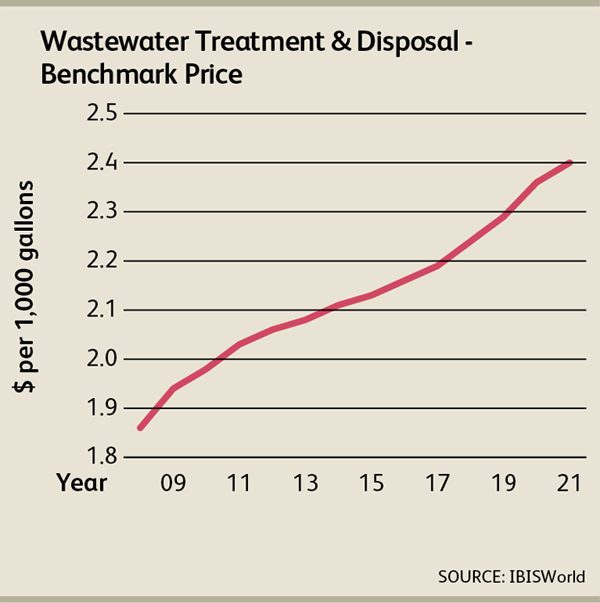Natural Disasters: Rebuilding From The Wreckage
By Margaret West, IBISWorld Procurement Research Analyst
Hurricanes and earthquakes throughout the world have been demonstrating the costly effects on not only service-related prices, but also on personal safety.
Recent hurricanes and earthquakes have had a disastrous impact on water infrastructure around the world. In the aftermath of Hurricanes Harvey and Irma, despite record rainfall, parts of the southern U.S. and Caribbean are currently water-stressed. Some areas of Texas still do not have access to safe drinking water, and many stores in Texas have spiked their prices for bottled water. According to the Washington Post, “One business sold bottles of water for a staggering $99 per case.” In Mexico, two high-magnitude earthquakes have shaken the country and left a number of regions without running water and electricity. All told, recent hurricanes and earthquakes have wreaked destruction across the globe, and IBISWorld expects recovery service costs to explode as businesses try to rebuild.
Municipal Water Needs
In the U.S., municipalities ensure water quality is up to U.S. EPA standards to avoid supplying contaminated or untreated water, which can lead to diseases. When a water treatment plant is impacted by a natural disaster, like an earthquake or a hurricane, pipelines can rupture and dams can flood, leaving them inoperable. As a result, potable water becomes a scarce and precious resource. Another common problem posed by natural disasters is electrical failure. The tremors of a quake or the strong winds of a hurricane can knock down power lines, leading to a blackout. Without electrical power, water pumps cannot work because they rely on an electric motor to operate. Hurricane Maria has taken out 100 percent of power in Puerto Rico, drying up the possibility of running water for the island’s residents and businesses. In this case, even if the water supply available is potable, people cannot access the water without the means to move it through the pipes.
Damage To The Power Generation And Agriculture Industries
Aside from municipalities, water is also a key component in the power generation and agriculture industries. If an earthquake causes a break in a water pipe or a hurricane contaminates a water source, various dependent operations can be impaired. In fact, power generation relies on water for operations; it is used for cooling in power plants, electricity generation in hydroelectric dams, as well as for the extraction and refinement of fuel. Flooding or tremors can damage the electrical equipment that is key to managing the flow of water for these sectors.
A similar effect can be seen in the agriculture industry. For example, the World Bank estimates that 70 percent of all freshwater withdrawals are for the cultivation of crops and the rearing of animals. Without enough water, the farming industry would essentially evaporate because all plants and animals require water to survive and flourish. Nepal’s Ministry of Agricultural Development estimates that the region’s agriculture industry lost $97.2 million in revenue after their 2015 earthquake, and the United Nations calculated that about 1.5 million people faced food shortages because of the temblor. Problems with water availability and quality in the agricultural community could lead to national, and even global, food shortages, costing the country more than just a loss in revenue.
Rebuilding Water Infrastructure
The water infrastructure sector also experiences the ripple effects of a hurricane or an earthquake. Procurement departments can expect price gouging as demand skyrockets for the products and services needed to repair and rebuild the infrastructure. For instance, as municipal water suppliers assess the damage to their plants and changes to water safety, IBISWorld expects demand for water damage restoration services, water quality testing services, and water treatment and disposal services to rise, resulting in exponentially higher prices. The cost of the repairs, additional testing and treatment will likely trigger a spike in water bills for consumers and businesses alike. Businesses can also expect water supply and irrigation system services and water and sewer line construction to become more expensive as businesses and consumers try to repair the damage to their water pipes and pumps. The price increases of these water infrastructure-related services mean costlier operations for businesses across multiple industries. As a consequence, the products of those affected industries are anticipated to become more expensive. For example, the bottled water market is also affected by natural disasters. Water contamination or loss of electricity for production machines causes supply to decrease, manufacturing costs to rise and demand to swell. These factors drive up the price of bottled water.

Improving Precautions
Natural disasters are destructive and their impact on multiple industries lasts far into the future. In fact, Louisiana is still recovering from Hurricane Katrina 12 years later, and Nepal is still recovering from its earthquake in 2015. By observing recovery strategies and economy-wide effects following these disasters, lessons in protection can be learned.
Since the 2011 earthquake in Japan caused a tsunami that resulted in the release of radioactive materials, nuclear plant safety regulations and practices have improved worldwide. By doing so, nuclear plants have minimized the risk of another such catastrophe.
Additionally, Mexico has adapted since its powerful earthquake in 1985. More than 400 buildings collapsed in Mexico City, and 10,000 people were estimated to have died in the quake. In the aftermath, the Mexican government updated its building codes, developed an early warning system and educated its people on earthquake safety procedures to prevent equally devastating losses in the future. While the recent earthquakes ripping through the region have claimed many buildings and lives, the numbers are much lower than the thousands in 1985. Finally, after the failure of levees in Louisiana during Hurricane Katrina in 2005, the damage was surveyed and studied to upgrade levee design and assessment for better hurricane protection in the U.S.
It takes years to achieve full recovery from the destruction of water infrastructure caused by natural disasters. It is always prudent to invest in disaster safety, such as creating disaster response plans, educating employees and citizens about safety procedures, securing building components, making structural modifications, and keeping buildings up to safety codes. By adopting these techniques, businesses and municipalities can minimize water infrastructure damage and their losses in the event of an earthquake or a hurricane.

Margaret West is a business research analyst for IBISWorld. She holds a bachelor's degree in statistics and East Asian studies from the University of Virginia. The research featured in this article can be found at www.ibisworld.com/procurement.
